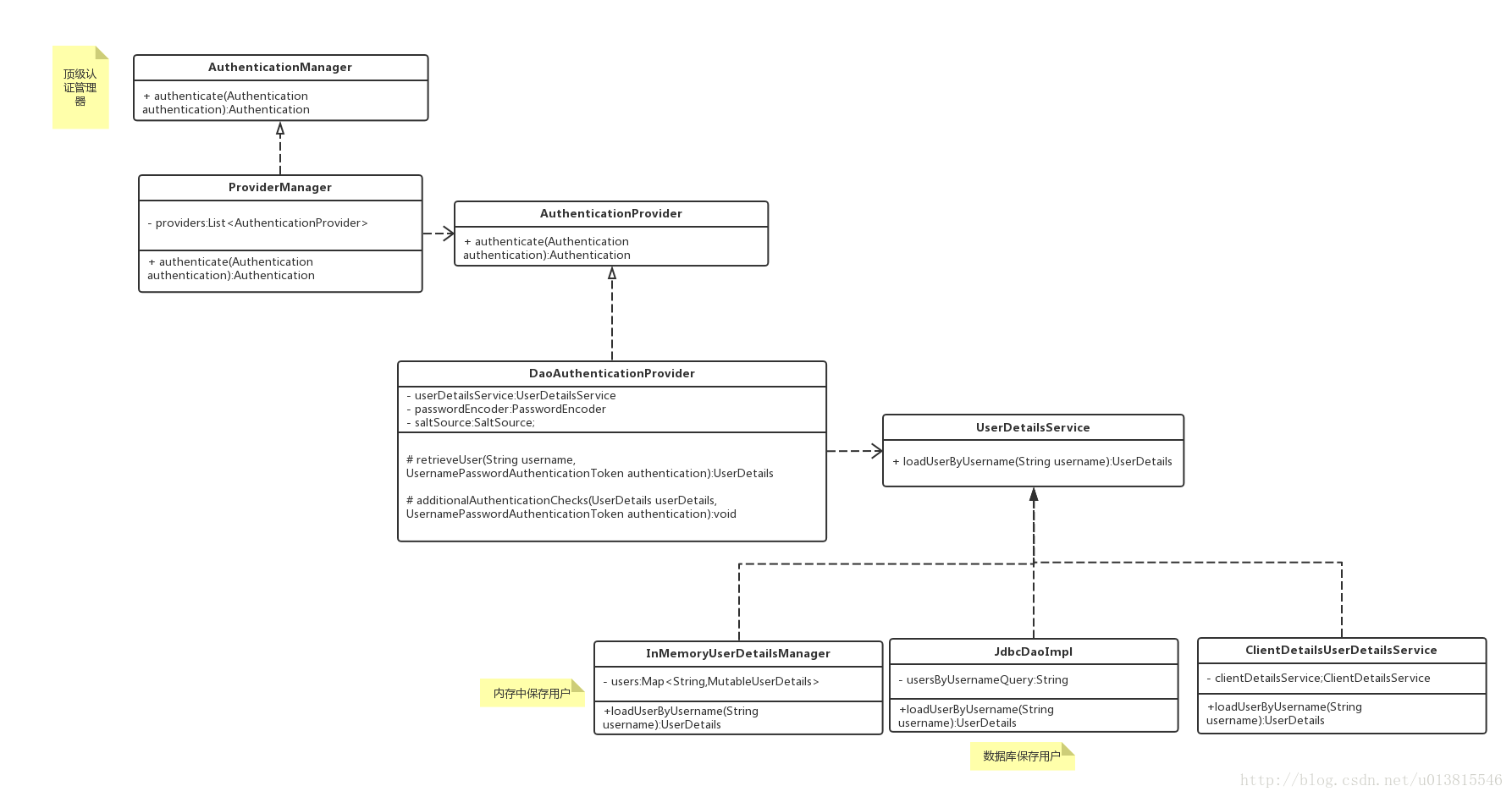这期内容当中小编将会给大家带来有关怎么看待Spring security oauth2的认证流程,文章内容丰富且以专业的角度为大家分析和叙述,阅读完这篇文章希望大家可以有所收获。
隐式授权模式(Implicit Grant)
需要提供的参数 地址: oauth/token 请求头参数: Authorization=Basic base64.encode(client_id:client_secret) ==如果secret为空,只对client_id进行编码== POST参数 grant_type:password username: 用户名 password:密码
client_credentials 认证
需要传递的参数
地址:
oauth/token
Header参数
client_id:
client_secret:
Header头添加
Authorization=Basic base64.encode(client_id:client_secret)
==如果secret为空,只对client_id进行编码==
Post参数
grant_type: password
scope: 作用域password 模式
需要传递的参数
地址:
oauth/token
Header参数
client_id:
client_secret:
Header头添加
Authorization=Basic base64.encode(client_id:client_secret)
==如果secret为空,只对client_id进行编码==
Post参数
grant_type: password
username: 用户名
password: 密码
scope: 作用域授权码模式
1.首先请求oauth/authorize 获取code
需要提交的参数
Header参数
client_id:
client_secret:
Header头添加
Authorization=Basic base64.encode(client_id:client_secret)
如果secret为空,只对client_id进行编码
post参数
grant_type: password
username: 用户名
password: 密码
scope: 作用域
2. 通过code 访问 oauth/token接口,换取回应的accessToken首先开启@EnableAuthorizationServer 注解
AuthorizationServerConfigurerAdapterm默认方法配置
public class AuthorizationServerConfigurerAdapter implements AuthorizationServerConfigurer {
@Override
public void configure(AuthorizationServerSecurityConfigurer security ) throws Exception {
// 配置AuthorizationServer安全认证的相关信息,创建ClientCredentialsTokenEndpointFilter核心过滤器
}
@Override
public void configure(ClientDetailsServiceConfigurer clients) throws Exception {
//配置OAuth3的客户端相关信息
}
@Override
public void configure(AuthorizationServerEndpointsConfigurer endpoints) throws Exception {
//配置AuthorizationServerEndpointsConfigurer众多相关类,包括配置身份认证器,配置认证方式,TokenStore,TokenGranter,OAuth3RequestFactory
}客户端身份认证核心过滤器ClientCredentialsTokenEndpointFilter
核心代码如下
public Authentication attemptAuthentication(HttpServletRequest request, HttpServletResponse response)
throws AuthenticationException, IOException, ServletException {
...
String clientId = request.getParameter("client_id");
String clientSecret = request.getParameter("client_secret");
...
clientId = clientId.trim();
UsernamePasswordAuthenticationToken authRequest = new UsernamePasswordAuthenticationToken(clientId,
clientSecret);
return this.getAuthenticationManager().authenticate(authRequest);顶级身份管理者AuthenticationManager

TokenEndpoint。
Token处理端点TokenEndpoint
前面的两个ClientCredentialsTokenEndpointFilter和AuthenticationManager可以理解为一些前置校验,和身份封装
@FrameworkEndpoint
public class TokenEndpoint extends AbstractEndpoint {
@RequestMapping(value = "/oauth/token", method=RequestMethod.POST)
public ResponseEntity<OAuth3AccessToken> postAccessToken(Principal principal, @RequestParam
Map<String, String> parameters) throws HttpRequestMethodNotSupportedException {
...
String clientId = getClientId(principal);
ClientDetails authenticatedClient = getClientDetailsService().loadClientByClientId(clientId);
//加载客户端信息
...
TokenRequest tokenRequest = getOAuth3RequestFactory().createTokenRequest(parameters, authenticatedClient);
//结合请求信息,创建TokenRequest
...
OAuth3AccessToken token = getTokenGranter().grant(tokenRequest.getGrantType(), tokenRequest);
//将TokenRequest传递给TokenGranter颁发token
...
return getResponse(token);
}
private TokenGranter tokenGranter;真正的/oauth/token端点,其中方法参数中的Principal经过之前的过滤器,已经被填充了相关的信息,而方法的内部则是依赖了一个TokenGranter 来颁发token。其中OAuth3AccessToken的实现类DefaultOAuth3AccessToken就是最终在控制台得到的token序列化之前的原始类:
public class DefaultOAuth3AccessToken implements Serializable, OAuth3AccessToken {
private static final long serialVersionUID = 914967629530462926L;
private String value;
private Date expiration;
private String tokenType = BEARER_TYPE.toLowerCase();
private OAuth3RefreshToken refreshToken;
private Set<String> scope;
private Map<String, Object> additionalInformation = Collections.emptyMap();
//getter,setter
}
@org.codehaus.jackson.map.annotate.JsonSerialize(using = OAuth3AccessTokenJackson1Serializer.class)
@org.codehaus.jackson.map.annotate.JsonDeserialize(using = OAuth3AccessTokenJackson1Deserializer.class)
@com.fasterxml.jackson.databind.annotation.JsonSerialize(using = OAuth3AccessTokenJackson2Serializer.class)
@com.fasterxml.jackson.databind.annotation.JsonDeserialize(using = OAuth3AccessTokenJackson2Deserializer.class)
public interface OAuth3AccessToken {
public static String BEARER_TYPE = "Bearer";
public static String OAUTH2_TYPE = "OAuth3";
/**
* The access token issued by the authorization server. This value is REQUIRED.
*/
public static String ACCESS_TOKEN = "access_token";
/**
* The type of the token issued as described in <a
* href="http://tools.ietf.org/html/draft-ietf-oauth-v2-22#section-7.1">Section 7.1</a>. Value is case insensitive.
* This value is REQUIRED.
*/
public static String TOKEN_TYPE = "token_type";
/**
* The lifetime in seconds of the access token. For example, the value "3600" denotes that the access token will
* expire in one hour from the time the response was generated. This value is OPTIONAL.
*/
public static String EXPIRES_IN = "expires_in";
/**
* The refresh token which can be used to obtain new access tokens using the same authorization grant as described
* in <a href="http://tools.ietf.org/html/draft-ietf-oauth-v2-22#section-6">Section 6</a>. This value is OPTIONAL.
*/
public static String REFRESH_TOKEN = "refresh_token";
/**
* The scope of the access token as described by <a
* href="http://tools.ietf.org/html/draft-ietf-oauth-v2-22#section-3.3">Section 3.3</a>
*/
public static String SCOPE = "scope";
...TokenGranter

TokenGranter的设计思路是使用CompositeTokenGranter管理一个List列表,每一种grantType对应一个具体的真正授权者,在debug过程中可以发现CompositeTokenGranter 内部就是在循环调用五种TokenGranter实现类的grant方法,而granter内部则是通过grantType来区分是否是各自的授权类型。
public class CompositeTokenGranter implements TokenGranter {
private final List<TokenGranter> tokenGranters;
public CompositeTokenGranter(List<TokenGranter> tokenGranters) {
this.tokenGranters = new ArrayList<TokenGranter>(tokenGranters);
}
public OAuth3AccessToken grant(String grantType, TokenRequest tokenRequest) {
for (TokenGranter granter : tokenGranters) {
OAuth3AccessToken grant = granter.grant(grantType, tokenRequest);
if (grant!=null) {
return grant;
}
}
return null;
}
}五种类型分别是:
ResourceOwnerPasswordTokenGranter ==> password密码模式
AuthorizationCodeTokenGranter ==> authorization_code授权码模式
ClientCredentialsTokenGranter ==> client_credentials客户端模式
ImplicitTokenGranter ==> implicit简化模式
RefreshTokenGranter ==>refresh_token 刷新token专用
以客户端模式为例,思考如何产生token的,则需要继续研究5种授权者的抽象类:AbstractTokenGranter
public abstract class AbstractTokenGranter implements TokenGranter {
protected final Log logger = LogFactory.getLog(getClass());
//与token相关的service,重点
private final AuthorizationServerTokenServices tokenServices;
//与clientDetails相关的service,重点
private final ClientDetailsService clientDetailsService;
//创建oauth3Request的工厂,重点
private final OAuth3RequestFactory requestFactory;
private final String grantType;
...
public OAuth3AccessToken grant(String grantType, TokenRequest tokenRequest) {
...
String clientId = tokenRequest.getClientId();
ClientDetails client = clientDetailsService.loadClientByClientId(clientId);
validateGrantType(grantType, client);
logger.debug("Getting access token for: " + clientId);
return getAccessToken(client, tokenRequest);
}
protected OAuth3AccessToken getAccessToken(ClientDetails client, TokenRequest tokenRequest) {
return tokenServices.createAccessToken(getOAuth3Authentication(client, tokenRequest));
}
protected OAuth3Authentication getOAuth3Authentication(ClientDetails client, TokenRequest tokenRequest) {
OAuth3Request storedOAuth3Request = requestFactory.createOAuth3Request(client, tokenRequest);
return new OAuth3Authentication(storedOAuth3Request, null);
}
...
}AuthorizationServerTokenServices分析重点
AuthorizationServer端的token操作service,接口设计如下:
public interface AuthorizationServerTokenServices {
//创建token
OAuth3AccessToken createAccessToken(OAuth3Authentication authentication) throws AuthenticationException;
//刷新token
OAuth3AccessToken refreshAccessToken(String refreshToken, TokenRequest tokenRequest)
throws AuthenticationException;
//获取token
OAuth3AccessToken getAccessToken(OAuth3Authentication authentication);
}在默认的实现类DefaultTokenServices中,可以看到token是如何产生的,并且了解了框架对token进行哪些信息的关联。
@Transactional
public OAuth3AccessToken createAccessToken(OAuth3Authentication authentication) throws AuthenticationException {
OAuth3AccessToken existingAccessToken = tokenStore.getAccessToken(authentication);
OAuth3RefreshToken refreshToken = null;
if (existingAccessToken != null) {
if (existingAccessToken.isExpired()) {
if (existingAccessToken.getRefreshToken() != null) {
refreshToken = existingAccessToken.getRefreshToken();
// The token store could remove the refresh token when the
// access token is removed, but we want to
// be sure...
tokenStore.removeRefreshToken(refreshToken);
}
tokenStore.removeAccessToken(existingAccessToken);
}
else {
// Re-store the access token in case the authentication has changed
tokenStore.storeAccessToken(existingAccessToken, authentication);
return existingAccessToken;
}
}
// Only create a new refresh token if there wasn't an existing one
// associated with an expired access token.
// Clients might be holding existing refresh tokens, so we re-use it in
// the case that the old access token
// expired.
if (refreshToken == null) {
refreshToken = createRefreshToken(authentication);
}
// But the refresh token itself might need to be re-issued if it has
// expired.
else if (refreshToken instanceof ExpiringOAuth3RefreshToken) {
ExpiringOAuth3RefreshToken expiring = (ExpiringOAuth3RefreshToken) refreshToken;
if (System.currentTimeMillis() > expiring.getExpiration().getTime()) {
refreshToken = createRefreshToken(authentication);
}
}
OAuth3AccessToken accessToken = createAccessToken(authentication, refreshToken);
tokenStore.storeAccessToken(accessToken, authentication);
// In case it was modified
refreshToken = accessToken.getRefreshToken();
if (refreshToken != null) {
tokenStore.storeRefreshToken(refreshToken, authentication);
}
return accessToken;
}AuthorizationServerTokenServices的作用,他提供了创建token,刷新token,获取token的实现。在创建token时,他会调用tokenStore对产生的token和相关信息存储到对应的实现类中,可以是redis,数据库,内存,jwt。
上述就是小编为大家分享的怎么看待Spring security oauth2的认证流程了,如果刚好有类似的疑惑,不妨参照上述分析进行理解。如果想知道更多相关知识,欢迎关注亿速云行业资讯频道。
亿速云「云服务器」,即开即用、新一代英特尔至强铂金CPU、三副本存储NVMe SSD云盘,价格低至29元/月。点击查看>>
免责声明:本站发布的内容(图片、视频和文字)以原创、转载和分享为主,文章观点不代表本网站立场,如果涉及侵权请联系站长邮箱:is@yisu.com进行举报,并提供相关证据,一经查实,将立刻删除涉嫌侵权内容。
原文链接:https://my.oschina.net/wwh/blog/3094281